The Principality of Monaco is a small independent state in the Cote d’Azur, which is historically closely connected with France. According to the Constitution adopted in 1962, Monaco is a hereditary constitutional monarchy, so the head of the state is the Prince, and the crown passes to the direct legal heirs based on the age criterion. From 2005 until nowadays His Highness Excellency Prince Albert II has been reining the country, having inherited the crown from his father Prince Rainier III.
Monaco has an area of only 1,95 sq. m., and is divided into five districts (also known as quarters). Monaco-Ville (aka La Rocher, or the Rocks) is a historic center of the city, where the Prince’s Palace, the main Cathedral, and the popular Oceanographic Museum are located. The Condamine region surrounds the main port of the Principality (the Port Hercules). Monte-Carlo district is a center of attraction for tourists and shopping lovers, and the Casino, the Opera, the main five-star hotels, and the famous brands boutiques are all located there. Larvotto is the closest district to the Mediterranean Sea and the beach.
Fontieville is the district to the left from the Monaco-Ville, which was artificially created in the second half of the twentieth century. You will find here the circus, the rosary, the helicopter port, the stadium, and a big trade center with a hypermarket called Carrefour. There are also La Russe district that extends towards Italy and Jardin Exotique in the upper part of the Principality with a namesake exotic park and a cozy children’s park named after Princess Antoinette. These are sort of local community districts of Monaco, and tourists are rare here.
According to the census results in 2010, the population of the country is 36,000 people, 7,600 of who are Monaco nationals, the Monegasques, and the rest 80% of population are foreign residents of the Principality. About 30% of Monaco residents are French, and there is also a big Italian community. The official language in Monaco is French, but many people are also fluent in English and Italian. The traditional language of Monaco is a peculiar dialect used by the “oldest” representatives of the state, and taught in the public schools of the Principality.
The currency in Monaco is euro.
The national religion is Catholicism.
The national holiday is November 19 with the Principality decorated in white-and-red colors of the national flag for this day.
Monaco’s motto is “Deo Juvante”,which is Latin for “With God’s Help”.





